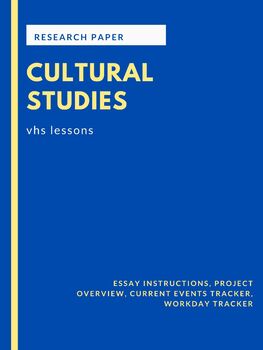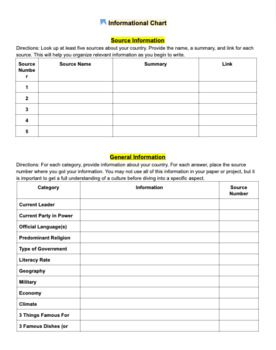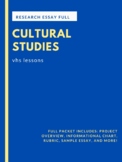World Literature: Cultural Studies Research Project
VHS Lessons
12 Followers
Grade Levels
9th - 12th, Higher Education, Homeschool
Resource Type
Standards
CCSSW.9-10.2
CCSSW.9-10.2a
CCSSW.9-10.2b
CCSSW.9-10.2c
CCSSW.9-10.2d
Formats Included
- PDF
Pages
11 pages
VHS Lessons
12 Followers
Also included in
- This is the full packet of all available materials for the semester long Cultural Studies Research essay. I use this in my World Literature class every year. This packet includes: 1. Project overview (instructions for students)2. Letter home for parents3. Informational Chart4. Proposal Instructions5Price $12.00Original Price $17.00Save $5.00
Description
In my World Literature course, I have students complete a year long Cultural Studies project. They pick a country/region with which they are not familiar and research it to better understand a different perspective. They have to then write a ten page research paper focusing on aspects of what they have learned. I usually complete this paper with juniors and seniors, but it can completely be adapted for different age and grade levels; the ultimate message--of learning about perspectives other than their own--is good for any age.
Included in this package is:
1. Project Overview (instructions for students)
2. Informational Chart
3. Proposal Instructions
4. Workday Tracker
5. Current Events Tracker
Total Pages
11 pages
Answer Key
N/A
Teaching Duration
1 Semester
Report this resource to TPT
Reported resources will be reviewed by our team. Report this resource to let us know if this resource violates TPT’s content guidelines.
Standards
to see state-specific standards (only available in the US).
CCSSW.9-10.2
Write informative/explanatory texts to examine and convey complex ideas, concepts, and information clearly and accurately through the effective selection, organization, and analysis of content.
CCSSW.9-10.2a
Introduce a topic; organize complex ideas, concepts, and information to make important connections and distinctions; include formatting (e.g., headings), graphics (e.g., figures, tables), and multimedia when useful to aiding comprehension.
CCSSW.9-10.2b
Develop the topic with well-chosen, relevant, and sufficient facts, extended definitions, concrete details, quotations, or other information and examples appropriate to the audience’s knowledge of the topic.
CCSSW.9-10.2c
Use appropriate and varied transitions to link the major sections of the text, create cohesion, and clarify the relationships among complex ideas and concepts.
CCSSW.9-10.2d
Use precise language and domain-specific vocabulary to manage the complexity of the topic.





